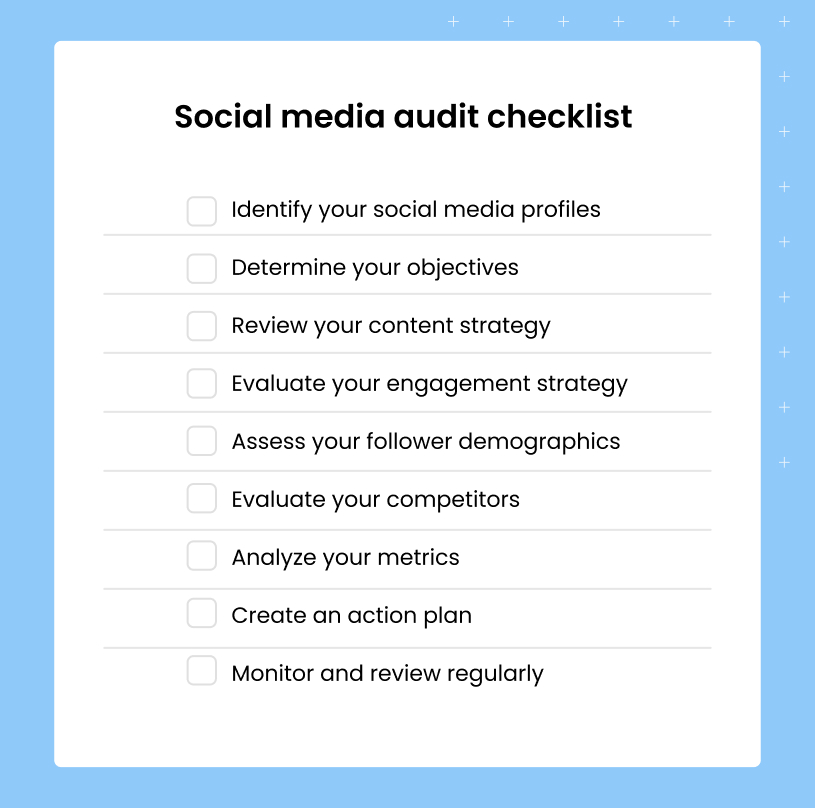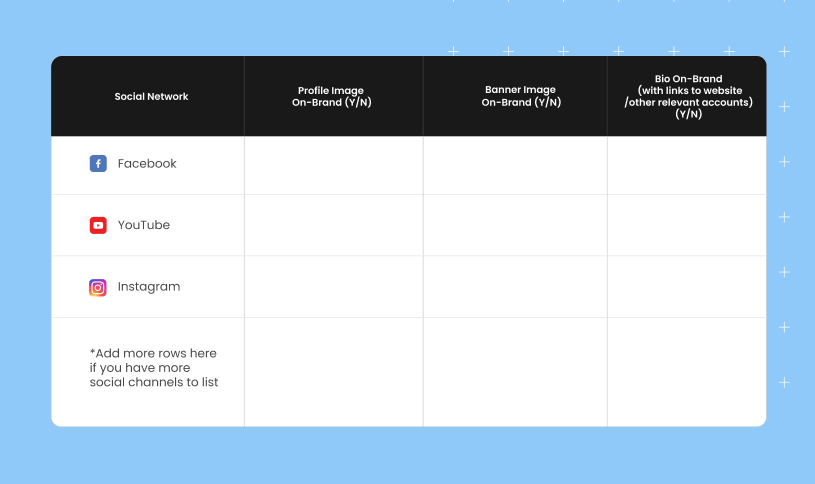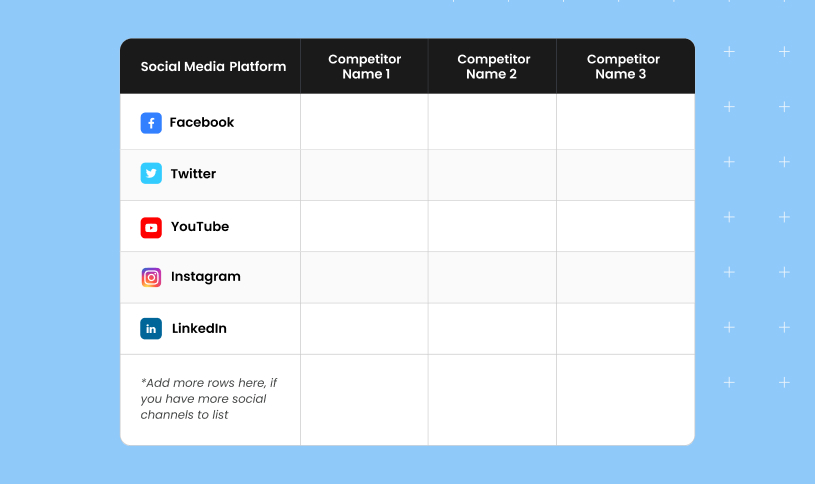Social media is a crucial component of any company’s marketing strategy. With billions of people using social media platforms every day, it’s no wonder businesses are eager to establish a strong online presence. However, simply having a presence on social media just isn’t enough.
By conducting a regular social media audit, companies can make sure they’re maximizing their social media presence. Audits allow businesses to spot weaknesses, track progress, and eventually drive higher engagement and conversions, delivering a tangible impact on their bottom line.
In this article, we’ll cover what a social media audit is, how to do an audit, and provide a free, comprehensive social media audit template for businesses to use right away.
Table of contents
What is a social media audit?

A social media audit is when a business evaluates its social media presence to determine what’s working and what’s not. The audit typically involves a thorough analysis of a company’s social media profiles, content, and performance metrics, with the goal of identifying areas for improvement and opportunities for growth.
You might be asking yourself, “Why would I want to conduct a social media audit?” Well, it’s because an audit of social media is an essential tool for any business looking to improve its social media presence and maximize its return on investment from social media marketing efforts.
Your social media checklist to get started

Using a social media audit checklist provides clarity on what to look for and what to measure, making the audit process more structured and efficient. A checklist saves time because you’re evaluating each social media platform in the same way. This consistency helps you identify patterns and trends across platforms, making it easier to compare your performance.

The checklist in more detail
Here is a comprehensive social media audit checklist that can help you analyze your social media presence:
- Identify your social media profiles: List all the social platforms you’re currently using for your brand. Make sure you have complete and updated information on each platform, including profile pictures, bios, and contact information.
- Determine your objectives: Define the objectives of your social media presence, such as brand awareness, lead generation, customer service, or community building. Review your social media profiles and make sure your objectives are clearly reflected in your content and engagement strategies.
- Review your content strategy: Evaluate the quality and relevance of your content and check whether it aligns with your brand voice, tone, and messaging. The social media content audit analyzes the types of content that perform well and identifies the areas where you need to improve. Check the frequency of your posts and determine if it’s optimal for each platform.
- Evaluate your engagement strategy: Analyze your engagement metrics, including likes, comments, shares, and direct messages, to determine how your audience is responding to your content. Evaluate your response rate and time to customer inquiries and messages. Check if you are responding to both positive and negative comments and reviews.
- Assess your follower demographics: Analyze your follower demographics, such as age, gender, location, and interests, to determine if your content aligns with your target audience. Identify the platforms where your target audience is most active and adjust your content and engagement strategies accordingly.
- Evaluate your competitors: Identify your top competitors and analyze their social media presence, including their content strategy, engagement metrics, and follower demographics. Determine what they are doing well and identify areas where you can differentiate yourself.
- Analyze your metrics: Use social media analytics tools to measure key performance indicators (KPIs) such as reach, engagement, follower growth, and conversion rates. Compare your metrics with your objectives and benchmarks to determine where you stand and what you need to improve.
- Create an action plan: After reviewing your audit results, create an action plan that includes specific recommendations and strategies to improve your social media presence. Set SMART goals and prioritize the actions that will have the most significant impact on achieving your objectives.
- Monitor and review: Monitor your social media metrics regularly to track your progress and adjust your strategies as needed. Conduct periodic social media audits to ensure that you are continually improving and adapting to the ever-evolving changes in the social media landscape.
How to do a social media audit in 7 steps

The audit of social media is the actual evaluation process that involves analyzing your social media profiles based on the checklist. Here are the seven steps to conduct a social media audit:
Step 1: Define your goals and objectives
Start by defining the goals and objectives of your social media audit. What do you hope to achieve by conducting the audit? Are you looking to improve engagement, increase brand awareness, or generate more leads?
Step 2: Identify your social media profiles

In this step, make a list of all the social media profiles associated with your business. This could include Facebook, Twitter, LinkedIn, Instagram, and any other platforms your business is using. This includes all your active and inactive profiles and any brand or product names associated with your business.
Pro tip: Include all social media platforms, not just the ones you use regularly. Once you have your list, plan to deal with any troublesome accounts you may have discovered. This could include impostor accounts or copyrighted material infringement. If you find anything out of the ordinary, take action to address the issue immediately before it harms your brand’s reputation.
Step 3: Assess your profiles

Review each of your social media profiles and evaluate their effectiveness. Ask yourself the following questions:
- Is your profile set up properly? Is the information up-to-date and accurate?
- Do your profile pictures, and cover images reflect your brand?
- Are you using the appropriate keywords and hashtags to make your profiles more discoverable?
To start, check in on your branding across all social media platforms. Review critical areas for each social media account, including all of the following:
- Profile and cover images: Make sure all images reflect your current branding and adhere to the image size requirements for each platform
- Profile/bio text: Make sure all fields are accurately filled in, and that copy matches your brand’s tone and voice guidelines
- Username: Use the same name on each of your social media accounts
- URL: Make sure the link in your profile directs to the right web page or landing page
- Pinned posts (if applicable): Evaluate pinned posts to ensure they are still appropriate and up-to-date
- Verification: Consider if an account should be verified with the platform

Step 4: Analyze your content
Review your social media posts over a period of time and analyze their performance. Which posts received the most engagement? Which posts performed poorly? Are there any trends or themes in your top-performing content that you can replicate?
It boils down to understanding what resonates with your target audience, figuring out what works, and then doing more of that.

To do that:
- Use the analytics tools each social network provides to identify your top posts.
- Take note of the engagement rate, link clicks, conversions, and other preferred metrics.
Next, define what a “top-performing post” means to you based on your metrics of choice. This will help you to evaluate your content better and make strategic decisions to improve your social media strategy.
Once you’ve identified your top-performing posts, look for patterns in the content. For instance, if you notice that your audience engages more with videos, it’s an indication that you should further incorporate video content into your social media strategy.
Step 5: Evaluate your metrics
Companies evaluate social media metrics by identifying and tracking key performance indicators (KPIs) that align with their social media goals. Some common KPIs include reach, engagement, conversions, and sentiment.
- Reach measures the size of the audience that sees a company’s social media content.
- Engagement measures the level of interaction users have with the content.
- Conversions track the number of users who take a desired action, such as making a purchase or filling out a form.
- Sentiment measures the overall tone of user feedback.
By evaluating these metrics, you can quickly determine if they are improving or declining over time. By regularly monitoring and analyzing these metrics, businesses can make data-driven decisions to improve their performance.
Step 6: Analyze your competitors

Analyze your competitors’ social media presence and identify what’s working for them by doing an industry social media audit. Are they using any strategies or tactics that you can adopt in your own social media strategy?
Look at what your competitors are doing well and where they fall short in engagement rates, follower counts, and content strategy. Stay informed and ahead of industry trends, and track any changes in your competitors’ social media strategies. This will help you develop a plan to differentiate yourself and stand out in your industry.
Step 7: Develop an action plan
Based on your findings, develop an action plan for improving your social media presence. This plan should include specific recommendations for optimizing your profiles, content, and metrics.
By following these steps, you can conduct a thorough social media audit that will help you identify areas for improvement and develop a more effective social media strategy.
Download a free social media template
We’ve created a free social media audit template that you can start using right away. Our free social media audit tool is designed to help you evaluate your social media presence holistically and identify areas for improvement.
With our template, you can easily track your progress and identify the strengths and weaknesses of your social media strategy. Click on the link below and make a copy of the template that can be further customized, allowing you to tailor it to your specific needs and goals.
Get the social media audit report template for free and start using it today.
[Free Template] Social media audit template
Download Now
Social media audit examples
Now that you have a better idea of what a social media audit involves let’s look at a few business use cases.
eCommerce business
By conducting a social media audit, an eCommerce business can identify what’s working and what’s not working in their social media strategy. They can then use this information to make informed decisions and take steps to improve their social media presence.
For example, the company may identify that the Instagram Reels are performing particularly well, so they decide to create more Reels. Additionally, they may find that their target audience on Instagram is primarily female and aged between 18-34, so they focus their content strategy on appealing to this demographic.
Dental practice
A dental practice’s audit may find that the most engaged followers are interested in orthodontic services, so they create more content related to orthodontics. Additionally, they may find that their target audience on Facebook is primarily aged between 35-54, so they focus their content strategy towards this demographic.
The social media audit provides valuable insights that the dental practice can use to refine its social media strategy and achieve its objectives. Moreover, analyzing patient reviews can help them understand their customers better and work on improving their services. A social media campaign audit can help dental practices optimize their ad spend and improve their return on investment.
Frequently asked questions about a social media audit
When conducting a social media audit, you should be asking the following four questions:
1. Are our social media profiles complete and up-to-date?
2. Is our content engaging and relevant to our target audience?
3. Are we reaching our social media goals and objectives?
4. How do we compare to our competitors in terms of social media presence and performance?
A social media audit is essentially an examination of a company’s social media presence. It involves evaluating the company’s social media profiles, analyzing audience engagement, and reviewing the content strategy.
A social media marketing audit is a process of evaluating and analyzing a company’s social media presence, strategies, and performance to identify strengths, weaknesses, and opportunities for improvement.
The cost of a social media audit varies depending on several factors, such as the complexity of the audit, the size of the business, the number of social media platforms to be audited, and the expertise of the person or agency performing the audit. The cost of a social media audit can range from a few hundred dollars to several thousand dollars.
In order to a company’s social media presence, start by reviewing their social media profiles, content, engagement, and metrics. Then, analyze their competitors, industry trends, and audience behavior to identify areas for improvement and make recommendations for a more effective social media strategy.
Audit social media campaigns with Birdeye
Birdeye Social provides companies with reports that measure their top-performing content, social reach, engagement, and audience growth by location or region — uncovering insights and trends that can be used to optimize their overall social media strategy. For more information on how Birdeye can help your business, watch a demo and book a time to chat with a Birdeye product expert.

This blog post is part of our Social Media Management Guide
Originally published









